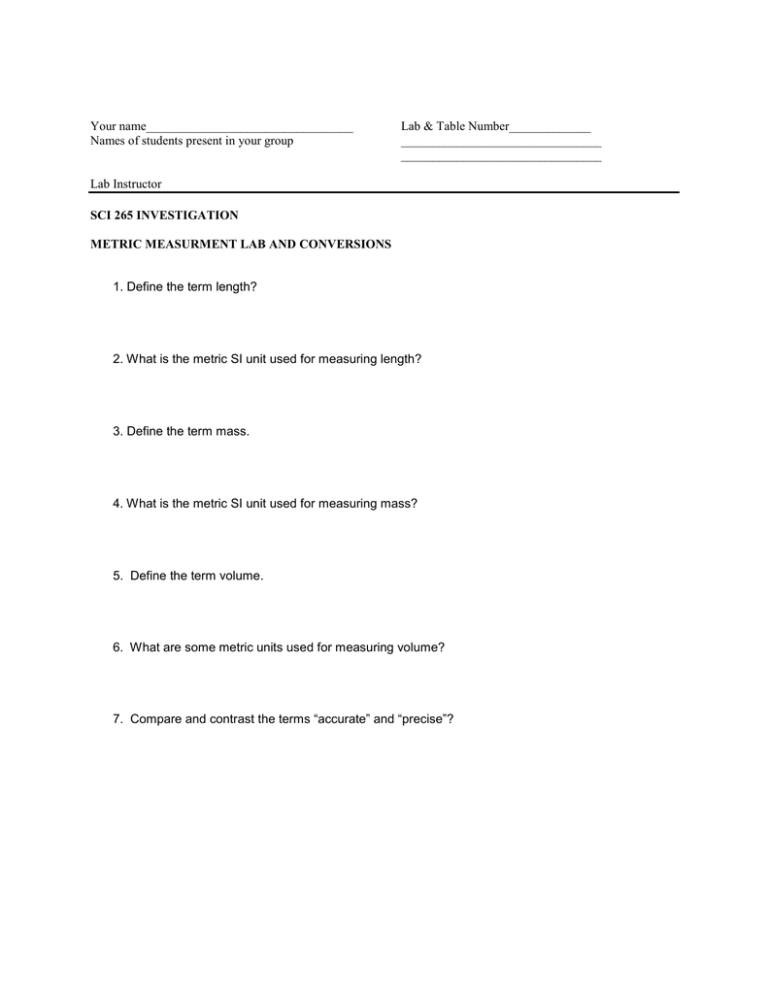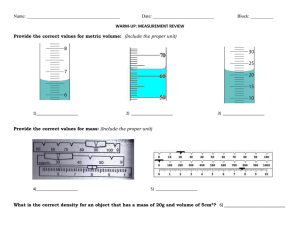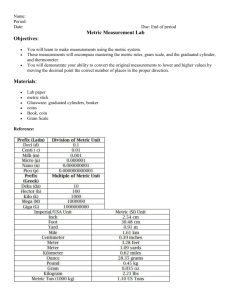Measurement
advertisement

Your name_________________________________ Names of students present in your group Lab & Table Number_____________ ________________________________ ________________________________ Lab Instructor SCI 265 INVESTIGATION METRIC MEASURMENT LAB AND CONVERSIONS 1. Define the term length? 2. What is the metric SI unit used for measuring length? 3. Define the term mass. 4. What is the metric SI unit used for measuring mass? 5. Define the term volume. 6. What are some metric units used for measuring volume? 7. Compare and contrast the terms “accurate” and “precise”? INTRODUCTION To become proficient in measuring in science, you must master the metric system of measurements. You are probably not too familiar with the metric system of measurements since it is not a part of your daily life. It is important to use the metric system in science because not only is it recognized internationally, but it is also the standard on which all science measurements, calculations, and conversions are based. The metric system of measurements is based on multiples of ten. It uses standard units to which prefixes are applied. You need to memorize the multiplying factors for the common prefixes. Below are tables that list common metric prefixes and tell standard units. Table 1: Common Metric Prefixes Prefix TeraGigaMegaDecaDeciCentiMilliMicroNanoPico- Symbol T G M Da d c m µ n p Multiplying Factor 1,000,000,000,000 1,000,000,000 1,000,000 10 0.1 0.01 0.001 0.000 001 0.000 000 001 0.000 000 000 001 Because the metric system is based on ten – all prefixes represent a factor of 10, you can make conversions by multiplying or dividing by factors of ten. A simple way of multiplying or dividing by ten is to move the decimal point to the right or left. Whether you move the decimal point to the right or left depends upon whether or not you are converting to a larger of smaller unit. When converting to a smaller unit, move the decimal point to the right – thus 1.6 kilometers becomes 1,600 meters. When converting to larger units, move the decimal place to the left. 950 milliliters equals .950 liters. Materials: metric sticks and rulers glassware: graduated cylinders, beaker, pipetts coin balance thermometer Procedures and Data: 1. Linear Measure Use the metric stick to measure the items listed below. Place your measurements in the spaces below. Above each column write the name of the unit that is abbreviated below it. Circle the unit you used to directly measure with for each item. You will need to convert for the other units. Item Diameter of the coin Width of the lab bench Your height m cm mm 1a.What would be an appropriate unit to express the size of each item? 1b. Convert your height to inches and then to feet. (1in=2.54 cm, 1m = 3ft) 2. Mass/Weight The balance is one of the most widely used tools in a chemistry lab. It is a delicate instrument and highly accurate when used and maintained properly. Operating the analytical balance can be simple and accurate results can be obtained if certain procedures are followed and care is taken to insure the instrument stays in “top-notch” condition. One purpose of this lab is to learn proper weighing techniques and maintenance procedures to get the best possible results from the balance. Use the balance to mass the following materials. Place your measurements in the spaces below. Write the name of the unit above the columns below. Item Mass of coin Mass of empty 10 mL graduated cylinder Mass of graduated cylinder with 10 mL water Mass of 10 mL water mg 2a.What is the difference between weight and mass? 2b. Why are they used synonymously on Earth? 2c. Convert your weight from pounds (lb) to kg. 3. Accuracy of volume measurements (of liquids) In this lab session you will become familiar with glassware used to measure the volume of liquids. A graduated cylinder is narrow so that small changes in volume can be detected more easily on the graduated scale. A 100 mL graduated cylinder is accurate to within 0.5 mL. A 10 mL graduated cylinder is accurate to within 0.1 mL. g kg When reading the volume on a graduated cylinder, try to be as precise as possible. You must estimate the value of the reading in-between graduation marks (i.e., 9.65 mL in a 10 mL graduated cylinder). Aqueous solutions have a meniscus, a curvature of the solution where it meets the walls of the cylinder (see above). The standard procedure is to read the value at the bottom of the meniscus. Mass of empty 100 mL beaker____________. Using each of the items listed, transfer 10.0 mL of water into the empty beaker and weigh. Determine the volume transferred with each item from the density of water (1g/mL). Place your measurements in the space below. mass (g) volume (mL) 10 mL graduated cylinder 100 mL beaker 10 mL volumetric pipette 50 mL beaker 50 mL graduated cylinder 3a. Do all of the glassware measure with the same degree of accuracy? Explain. 3b.What determines which glassware you measure with? 3c.What is a meniscus? Why is it necessary to know about it when measuring liquids? 4. Temperature Use the thermometer to measure the temperature of the following items. Write the name of the unit measure above the column that contains its abbreviation. F C K Ice water Boiling water Room temperature Ice water and salt 4a.How did you determine the values for K? K= C + 273.15 F = 9/5( C) + 32 C = 5/9( F − 32) 4b.What is the normal body temperature in F__ C_____ 4c. How is the temperature of water affected by the addition of salt? 4d. What would be some practical applications of this observation? Follow up question 1. If you are changing g to mg what direction do you multiply or divide by 1000? 2. If we are moving the decimal point to the right we are moving from a _______ unit to a _________ unit. 3. What sources of error would account for differences in measurement of the same thing? The accuracy of the measuring tool. 4. Perform the following conversions: A. 1.5 liter L =__________mL B. 700g = __________kg C. 70 kg = ________lb D. 40° C = ________ ° F





